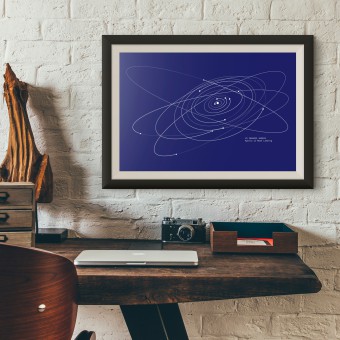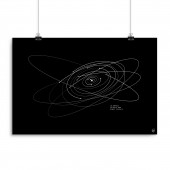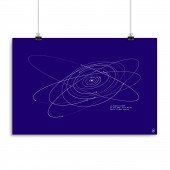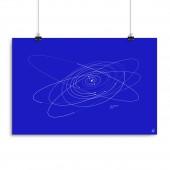
| THE AWARD |
| CATEGORIES |
| REGISTRATION |
| SUBMIT YOUR WORK |
| ENTRY INSTRUCTIONS |
| TERMS & CONDITIONS |
| PUBLICATIONS |
| DATES & FEES |
| METHODOLOGY |
| CONTACT |
| WINNERS |
| PRESS ROOM |
| GET INVOLVED |
| DESIGN PRIZE |
| DESIGN STORE |
| THE AWARD | JURY | CATEGORIES | REGISTRATION | PRESS | WINNERS | PUBLICATIONS | ENTRY INSTRUCTIONS |
Spacetime Coordinates Poster by river |
Home > Winners > Design #42617 >Interview |
 |
|
FS: What is the main principle, idea and inspiration behind your design?
AG: This design project helps us relate to the solar system itself and find our place in the universe. We might all just be space dust in the big picture, but this project gives us a chance to grasp our own individual humanity and ephemeral time on earth. We all are part of the universe, so let's make it count!
FS: What has been your main focus in designing this work? Especially what did you want to achieve?
AG: I wanted everyone to be able to discover the solar system on the personal human scale, using a birthdate, historical or individual achievement.
FS: What are your future plans for this award winning design?
AG: I will soon release a new Kickstarter campaign of a wearable design based on the same concept. I also want to work on new colors / styles for this design and possibly new forms.
FS: How long did it take you to design this particular concept?
AG: It took me a few months, from finding the most visually pleasing view of the solar system, to researching how to make the most accurate model possible and to the creation of the script that generates each personalised solar systems based on a given date, using data from NASA.
FS: Why did you design this particular concept? Was this design commissioned or did you decide to pursuit an inspiration?
AG: I've always loved anything space related, there is a zen quality I find in contemplating pictures of the universe, it helps me relax when I'm anxious, helps me put things in perspective as well.
FS: Is your design being produced or used by another company, or do you plan to sell or lease the production rights or do you intent to produce your work yourself?
AG: The design is produced and sold by me. It's been launched as a Kickstarter campaign in August 2015, and raised 83 660 Euros from 1 514 backers. Production started in November 2015 in the USA. More than 1600 posters have been printed.
FS: What made you design this particular type of work?
AG: I recently got obsessed by the idea of seeing a specific date within the solar system.
FS: Where there any other designs and/or designers that helped the influence the design of your work?
AG: yes, The Present by Scott Thrift was a major inspiration to this design. https://www.kickstarter.com/projects/scottthrift/the-present
FS: Who is the target customer for his design?
AG: Anyone who is interested by space, astronomy or science in general. Adults and kids.
FS: How did you come up with the name for this design? What does it mean?
AG: After extensive research of the subject of time and space, I came up with this name which is really is the definition of a peculiar point in time and space. So, it was just fitting.
FS: Which design tools did you use when you were working on this project?
AG: Illustrator and Javascript.
FS: What is the most unique aspect of your design?
AG: The personalisation of each design, using a particular date.
FS: Who did you collaborate with for this design? Did you work with people with technical / specialized skills?
AG: I collaborated with the great developer Martin Vézina who created the script using the data from NASA to generate an Illustrator file. He created an amazing interactive Solar System. https://open.nasa.gov/data-stories/solar-system-simulator/
FS: What is the role of technology in this particular design?
AG: Well, this design would have been absolutely impossible without technology! From the work of NASA, to the work of individuals scientists and developers who worked on calculating the exact velocity of each planet and their orbits.
FS: Is your design influenced by data or analytical research in any way? What kind of research did you conduct for making this design?
AG: This design is based of the data coming from NASA, in order to get the most accurate planets positions and up to date data.
FS: What are some of the challenges you faced during the design/realization of your concept?
AG: Mainly to find a developer who would be able to create an Illustrator script that would calculate the placement of each planets given a date.
FS: How did you decide to submit your design to an international design competition?
AG: Given how popular this project has been on Kickstarter, I figured it had a fair chance to win.
FS: What did you learn or how did you improve yourself during the designing of this work?
AG: I've learned that I should give myself more time when calculating a fulfillment estimate. I had to work non-stop for months, with hardly any break at all, in order to meet the deadlines.
FS: Any other things you would like to cover that have not been covered in these questions?
AG: This schematised design of the solar system use data from NASA's JPL for accurate planets' placement. The four dimensions (x, y, z, t) are used to represent a particular location in time and space. x, y, z are set to the heliocentric view that I've found the most visually pleasing. The orbital paths are illustrated in gradient lines, illustrating the counterclockwise direction of all the planets. Their sizes as well as the distances between them are schematised in order to make all the orbits and objects visibles at this scale.
FS: Thank you for providing us with this opportunity to interview you.
A' Design Award and Competitions grants rights to press members and bloggers to use parts of this interview. This interview is provided as it is; DesignPRWire and A' Design Award and Competitions cannot be held responsible for the answers given by participating designers.
| SOCIAL |
| + Add to Likes / Favorites | Send to My Email | Comment | View Press-Release | Translations |





